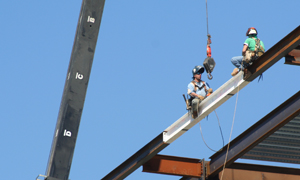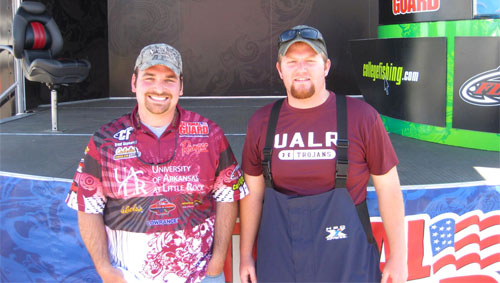What is it like to work at a major literary journal? How can an English major gain a foothold in the publishing industry? What’s the best way to submit story ideas or manuscripts?
Those questions and many more were topics of conversation as Carol Ann Fitzgerald, managing editor of The Oxford American, accompanied by Wes Enzinna, associate editor, visited with UALR English students on a rainy day in March.
A few weeks earlier in February, the publisher of the Oxford American, Warwick Sabin, offered his insights on the topic of magazines in the digital age. View the entire video below.
There is so much to love about graduation. Don’t tell the boss, but I actually enjoy working the weekend to go behind the scenes during commencement because there’s just nothing like it. It is the day when joy is evident, energy is palpable, and hard work is met with triumph.
After all, THIS is what we do. It is the fundamental mission of our university— to prepare our students to complete this chapter in their lives and transition successfully to the next.
And our job in the Office of Communications is to make commencement an event our students and faculty will never forget. Last year, we added another requirement to our role— make it a memorable social experience that transcends place.
This evolution began in Spring 2010 when we streamed the ceremony live over the internet for the first time and live-tweeted using the #UALRgrad hashtag so that friends and family, who couldn’t be present for the ceremony, could still experience the occasion across the miles.
This year, we did it again, and since we had a little bit of experience on our side, we added a few more social media bells and whistles. The idea was to create a space for interaction whether you were physically present in the Jack Stephens Center or virtually present online.
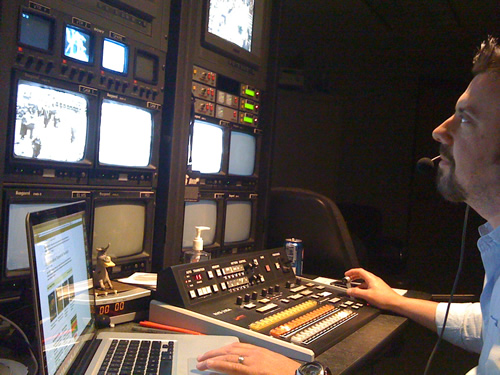
See the archived video of the ceremonies on the Commencement Experience web page.
What resulted was an aggregation of the different methods of participation that surrounded the video live stream, including a Facebook guestbook and live tweets. More than 700 users watched our live broadcast on May 21, and since then, approximately 670 have viewed the archived videos from each ceremony.
Also new, we asked grads and family members to submit photos to pics@ualr.edu and had staff correspondents behind the scenes and on the arena floor, uploading photos to Flickr.
 Photo Submission: Curtis Irvin, Jr.
Photo Submission: Curtis Irvin, Jr.
So tell us what you think. What more can we do to extend the graduation experience? In the meantime, check out all of the photos on our Flickr page and watch archived video from each of the May 21 ceremonies.
In February of 2010, NBC Nightly News profiled UALR grad student Spirit Trickey. We caught up with Spirit last week and asked her a few questions about the experience. View the video below.
Q&A With Spirit Trickey
What kind of feedback did you receive after your story was aired to a national audience? Tell us about that experience.
“Lorem ipsum dolor sit amet, consectetur adipiscing elit. Vestibulum aliquam gravida mauris, at ultricies ante consectetur dignissim. Curabitur in turpis at felis aliquet blandit. Nam dui enim, congue nec varius et, tempor vel purus. Aliquam dapibus facilisis velit, id consequat lacus varius in.
Duis lobortis odio eget risus iaculis vitae luctus quam pretium. Mauris pellentesque neque ac lectus varius fringilla. Vestibulum sit amet eros a dui tempus tempor. Sed ac risus dui, et posuere metus. Cras nec convallis nulla. Pellentesque habitant morbi tristique senectus et netus et malesuada fames ac turpis egestas.”
Another question. Another question.
“Lorem ipsum dolor sit amet, consectetur adipiscing elit. Vestibulum aliquam gravida mauris, at ultricies ante consectetur dignissim. Curabitur in turpis at felis aliquet blandit. Nam dui enim, congue nec varius et, tempor vel purus. Aliquam dapibus facilisis velit, id consequat lacus varius in. Duis lobortis odio eget risus iaculis vitae luctus quam pretium. Mauris pellentesque neque ac lectus varius fringilla. Vestibulum sit amet eros a dui tempus tempor.
Sed ac risus dui, et posuere metus. Cras nec convallis nulla. Pellentesque habitant morbi tristique senectus et netus et malesuada fames ac turpis egestas. Lorem ipsum dolor sit amet, consectetur adipiscing elit. Vestibulum aliquam gravida mauris, at ultricies ante consectetur dignissim. Curabitur in turpis at felis aliquet blandit. Nam dui enim, congue nec varius et, tempor vel purus. Aliquam dapibus facilisis velit, id consequat lacus varius in. Duis lobortis odio eget risus iaculis vitae luctus quam pretium.
Mauris pellentesque neque ac lectus varius fringilla. Vestibulum sit amet eros a dui tempus tempor. Sed ac risus dui, et posuere metus. Cras nec convallis nulla. Pellentesque habitant morbi tristique senectus et netus et malesuada fames ac turpis egestas.”
Commuters driving up and down South University may have thought they were seeing things. Was that a pretty substantial pine tree sitting on the top of the superstructure of UALR’s new nanotechnology building under construction on the west side of campus?
It was. Why? It’s an old construction tradition that when the last beam of a building’s superstructure is riveted in, a topping out ceremony follows, and a pine tree is placed on the top beam.
Sometimes, the last beam is painted white, and the builders sign their names on it. That’s what construction workers, students, faculty, and other stakeholders did at the EIT “sign the beam” ceremony in 2009.
No one seems to know for sure where the tradition started, but topping out ceremonies were common in the United Kingdom, Germany, Poland, and the Czech Republic, and the tradition emigrated to America with European tradesmen.
The topping out of the nanotechnology building dusted off a few memories for Mike Tramel, chair of UALR’s Construction Management program. Tramel has been to many a topping out party when he helped build mines, power plants, and other big industrial projects out West as a union ironworker in his youth.
“They didn’t have many pine trees out there, so we painted tumbleweed green and tied it to an American flag and topped out with that. Of course, this was before OSHA,” he said. And he said the parties were pretty rowdy. “They’d fill a pickup truck filled with beer and back it into the site.”
Tramel said ironworkers had several building traditions, including raising a black ribbon it the top of the structure in honor of a worker who died on the job.
“These days, topping out ceremonies are mostly done for public relations, especially for commercial buildings,” he said.
Anthropologists say the earliest references of topping out date from around 700 A.D., when Scandinavians topped off construction of new halls with sheathes of grain for Odin’s horse to assure good luck to future occupants of the building.
The Norman Invasion brought the tradition to Great Britain. Germans substituted small trees for sheathes of grain, and German tribes used only evergreens. It is thought that the tradition reached America via immigrant Norwegian ironworkers.
Americans added their own twist to the ceremony, hoisting an American flag beside the tree.
Looks like the tree atop the nanotechnology structure was removed for more construction work. But keep an eye out for the next topping out tree. It’s a salute to a thousand-year tradition.
Follow the progress of the nanotechnology building construction, and see renderings of this and other campus building projects on our construction website.
The following is courtesy of guest contributor, Eileen Turan, Donaghey Scholars program administrator.
Two UALR student organizations, the Donaghey Scholars Student Committee and the Art Student Association, partnered to present the 2nd annual smART: Artists and Scholars for a Cause fundraiser. As the staff advisor to the Donaghey Scholars Student Committee, I applaud the dozens of students who committed themselves to the event. The two student organizations presented Our House, a shelter for the working homeless, with a $2,120 check, more than doubling last year’s proceeds.

The students chose Our House as the recipient because they wanted to invest in a local organization where their efforts would not only make a significant difference, but would also help them gain recognition within the community. They also expressed admiration for the mission of the shelter, and for the leadership of UALR and Donaghey Scholar alumna Georgia Mjartan who serves as Executive Director of Our House.


The three day art show and sale featured the artwork of talented UALR students, faculty, staff, and alumni. Artwork sold for $20 or less to benefit the fundraiser. Artists also sold work for their own benefit. This year, a special door prize was donated by UALR applied design professor, Mia Hall. While the sale goal was to raise $2,000 for a local non-profit organization, the show also highlighted the exceptional talents of UALR artists.

I do not think it is unusual to find students raising money for their student organizations with events like bake sales and art sales. It is also not unusual for students to organize volunteer efforts for non-profits. What is unique about an event like smART is the dedication required by so many people. More than 25 artists, dozens of Donaghey Scholars, and several faculty, staff, and alumni came together, dedicating hours of preparation and planning to make this event a success. smART brought the community to UALR, united UALR departments and student organizations, and demonstrated that students can make a positive impact on their community and university.

To learn more about the Donaghey Scholars Program, visit ualr.edu/donagheyscholars. To learn more about the Art Department and Art Student Association, visit ualr.edu/art.
The University District Educational Network and Office of Community Engagement are hosting College Days for University District fifth graders. The first was April 27 for Bale Elementary. Wilson students will be on campus May 5, and Franklin is May 6. Friday Fellow students are tour guides talking about college life and career opportunities along the way.
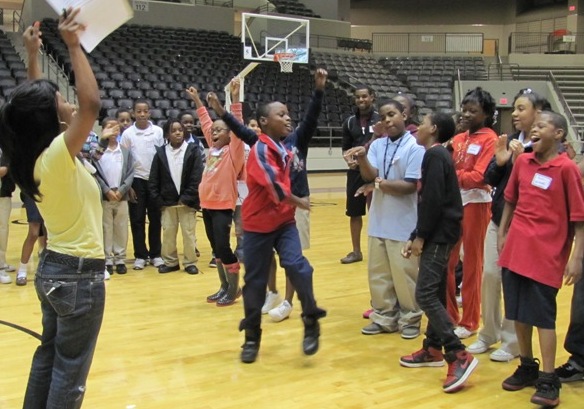 Team Polos is ready for the competition against two other teams. Reward: prizes for remembering careers that match up with degrees.
Team Polos is ready for the competition against two other teams. Reward: prizes for remembering careers that match up with degrees.
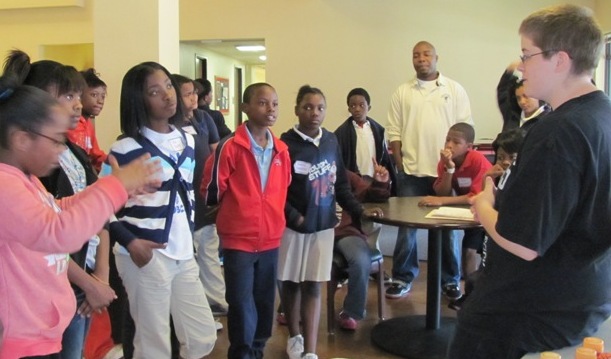 First stop: Mass comm sophomore Alychia Mills talked about friends she met while living in the apartments. Of course the natural questions — “Do you have a curfew?, Can you paint your room?, Put up pictures?, Do you like living in the dorm?”. “You get to know interesting people like from other countries.” “Cost?” “Get a scholarship, and you can live here free. How do get one? No, not just from sports.”
First stop: Mass comm sophomore Alychia Mills talked about friends she met while living in the apartments. Of course the natural questions — “Do you have a curfew?, Can you paint your room?, Put up pictures?, Do you like living in the dorm?”. “You get to know interesting people like from other countries.” “Cost?” “Get a scholarship, and you can live here free. How do get one? No, not just from sports.”
Next: RA Harold shows them the movie theater — where they were diggin’ video gaming — and a dorm room. Walking through DSC, I hear, “They got Taco Bell!” Outside the library I hear, “I’ve been in there.” She was proud to have been in a math competition as a third grader. Our tour guide points out Dickinson Hall, where you can become a teacher, like their teacher, Mr. Mills, who is one of our counseling master’s students.
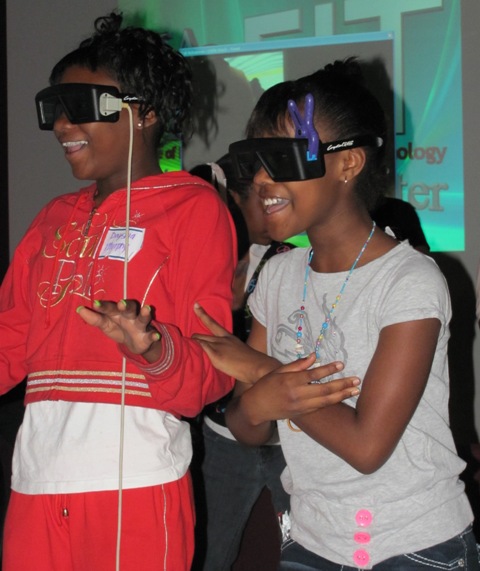 Then everyone’s favorite — the Virtual Reality Center.
Then everyone’s favorite — the Virtual Reality Center.
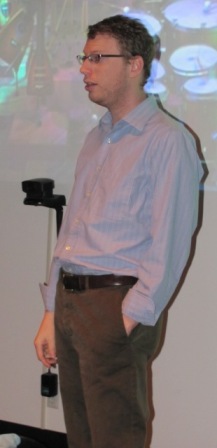 Ph.D. integrated computing student Erich Peterson, “Can you imagine how this system would be useful in the real world?” Car companies can change the color of a car or size of a window in 3D, med students can look at a human heart, architects have similar technology.
Ph.D. integrated computing student Erich Peterson, “Can you imagine how this system would be useful in the real world?” Car companies can change the color of a car or size of a window in 3D, med students can look at a human heart, architects have similar technology.
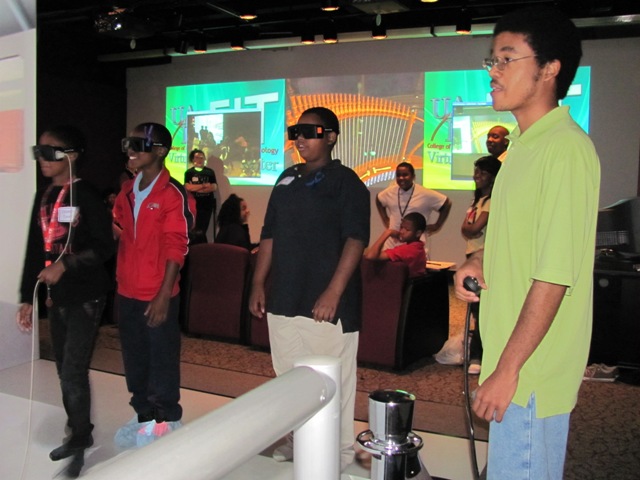 Undergrad Christian Storey demonstrates the “cave.”
Undergrad Christian Storey demonstrates the “cave.”
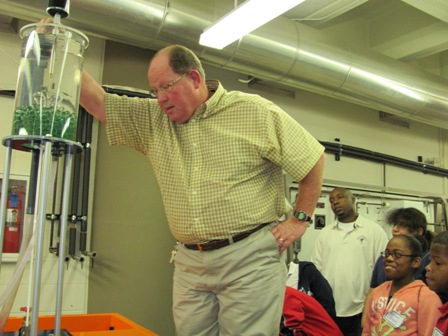 Now we hear from a researcher about fluids and air flow in the mechanical engineering lab. He demonstrates this apparatus that calculates ratio to create pressure. Why necessary? For civil engineers to build dams and military to use on submarines for speed and efficiency sound like pretty good reasons. I text my mechanical engineer husband that I’m hearing big words like inertia. Reply, “Don’t tell the kids how many hours we work.”
Now we hear from a researcher about fluids and air flow in the mechanical engineering lab. He demonstrates this apparatus that calculates ratio to create pressure. Why necessary? For civil engineers to build dams and military to use on submarines for speed and efficiency sound like pretty good reasons. I text my mechanical engineer husband that I’m hearing big words like inertia. Reply, “Don’t tell the kids how many hours we work.”
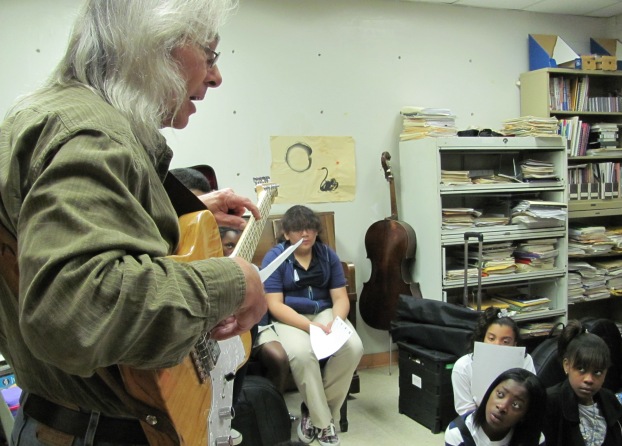 Another real-world lesson comes from guitar instructor Steve Struthers. “If you want to be a musician, you’re gonna be poor.” But he feels lucky to have always worked teaching guitar and playing jazz gigs. He doesn’t seem to mind 14-hour days, seven days a week. He strums chords from “Smoke on the Water” and “Jingle Bells,” beginning songs he teaches in elective classes, private lessons, or at the Summer Arts Camp. “How long have you been playing guitar?” “Since before the Beatles.” “Who?” They better related to him getting his first guitar on his 10th birthday.
Another real-world lesson comes from guitar instructor Steve Struthers. “If you want to be a musician, you’re gonna be poor.” But he feels lucky to have always worked teaching guitar and playing jazz gigs. He doesn’t seem to mind 14-hour days, seven days a week. He strums chords from “Smoke on the Water” and “Jingle Bells,” beginning songs he teaches in elective classes, private lessons, or at the Summer Arts Camp. “How long have you been playing guitar?” “Since before the Beatles.” “Who?” They better related to him getting his first guitar on his 10th birthday.
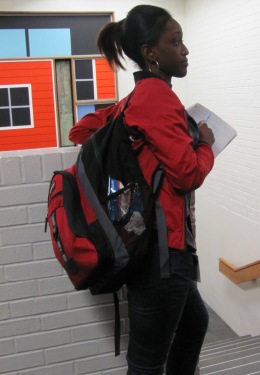 Nursing major Heather wraps up the tour with what you can be when you grow up by studying arts, humanities, or social sciences. So You Think You Can Dance? Being an actor or audio engineer sounded pretty cool too to the wide-eyed youngsters.
Nursing major Heather wraps up the tour with what you can be when you grow up by studying arts, humanities, or social sciences. So You Think You Can Dance? Being an actor or audio engineer sounded pretty cool too to the wide-eyed youngsters.
The following is courtesy of guest contributor, Tonya Oaks Smith, director of communications for the UALR William H. Bowen School of Law.
Thirty-seven years ago, the UALR William H. Bowen School of Law set the bar for law schools across the country – requiring legal skills classes for all students. The American Bar Association is only now requiring these classes be offered.
Bowen, however, is quickly moving into the next wave of legal-education innovation. The school is outfitted in video-capture cameras in its larger classrooms, providing students and professors the opportunity to view the class and any media used in the class. The captures are made available – with professor permission – online, so students can review difficult concepts and check their notes in preparation for final exams.
One large courtroom at Bowen was not outfitted with the latest and the greatest, however. The Friday Courtroom – the school’s most frequently used room for external continuing legal education (CLE) courses and events – did not have video-capture capabilities. Though it served as a hybrid classroom-lecture hall, it served none of its purposes to the fullest.
A $200,000 donation from the Friday, Eldredge, and Clark Law Firm remedied that problem. Construction began on the renovation in December 2010, and a reception Monday allowed visitors to see the transformation.
During the event, Dean John DiPippa unveiled a new technology framework for the courtroom, which was named in honor of the late Herschel Friday.
The facility now has video-capture and -conferencing capabilities. Its bench and new jury box are outfitted with monitors so that judges and juries can see the materials presented by attorneys in their arguments.
Television monitors lining the sides of the courtroom allow each observer the same access to justice information that those who sit closest to the front of the room have.
Students can now engage in moot court and trial competitions in the state-of-the-art room, and they will leave knowing they are truly prepared for the real courtroom. CLE event and guest speakers can now be streamed over the Internet or posted on the school’s website.
Some may remember that last year, Jeremy Reese and Trent Gephardt won the College Bass National Championship, placing first out of more than 50 of the top collegiate bass fishing teams in the country.
This year, the success continues with the UALR Bass Fishing Club.
Trent Gephardt and Carter Norman recently placed second in a National Guard FLW College Fishing Central Division event.
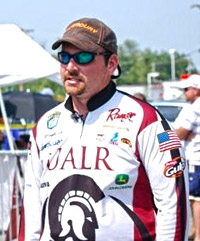
Q&A with Trent:
What is your major? What are you studying at UALR and what kind of career plans do you have?
My major is Biology (Fisheries and Wildlife management). My career hopefully will be in private consulting of water quality etc..
What happened to your old fishing partner Jeremy Reese? I’m seeing his name on last year’s championship article.
Jeremy Reese graduated the December after we won the National Championship in 08. He has since moved with his family back to South Carolina.
How does the UALR Bass Fishing Club work? How did it get started? I’m curious about how all that works.
The Bass Club is a student organization. We have about 14 members that are active in the club. It was started by Jeremy and a few others the spring of 08 to get to fish the national championship in Little Rock. Also it was a way to get anglers connected on campus. The club is pretty much geared for the bass tournament fisherman but we welcome all experience levels. We travel to several regional and national tournament events around the region.
So there are about 14 members.. How is it decided who will fish a particular tournament?
We hold several club tournaments to decide who gets to go. Also age limits some people. And some of the regional tournaments allow multiple teams to complete from a school.
Tell me about the tournaments themselves. What is the competition like? Do you notice any arrogance with teams from larger universities?
Most of the time guys from the bigger schools are pretty cool about things. We all have a common interest so it’s usually pretty easy to get along with them. Beating them of course makes it easier. (lol) And you earn the respect of being a solid fishermen.
How do local sponsors help the club?
We did have 4 companies this year that have been kind enough to help us out some, but other than that, it has been tough to get much in the way of local support. We have some national support in the way of line rods and product deals which helps tremendously.
How were you introduced to fishing?
I was introduced to fishing like most kids, through my dad. He is a bream fishermen and I have always had a fascination with bass. We would have small arguments when we went because he would be trying to bream fish and I would be trying to bass fish.
What style/method of fishing are you most comfortable with?
My style most favors a power fisherman’s style. I usually like to throw baits that move, that I can cover a lot of water with. My favorite lure to throw is a jig which forces me to slow down.
By finishing 2nd in the divisional tournament, you qualify to compete in the national college championship, right? Any thoughts or details about that?
Finishing 2nd in this event qualifies us to go to regions (not the national championship) which has yet to be announced. You have to make a top 5 at regionals to qualify for the national championship. We actually qualified last year finishing 3rd at Ouachita. We didn’t do so well at the regional in Indiana last year.
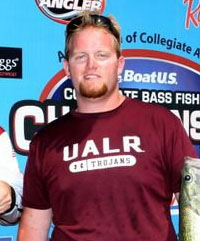
Q&A with Carter:
What is your major? Future career plans?
My major is nursing, and I’m actually starting the program this next fall. After graduation I would like to be a pediatric nurse. I love working with children and being able to help them would be a very beneficial job.
How did you become involved with UALR Bass Fishing?
I actually heard about the UALR Bass Club through a friend of mine that went to UALR, but graduated before he had a chance to join. I contacted the president at the time which was Trent Gephardt, and joined the team. Since then Trent and I have actually become fishing partners and good friends.
How were you introduced to fishing?
I’ve been fishing pretty much since I could hold a fishing rod. My dad, myself and my brothers would go over to my aunt’s pond and fish all the time. But I got into tournament fishing about 4 years ago when my friends got me to join the Jr Bassmaster White County club with them. And ever since it’s been my passion.
What style/method of fishing are you most comfortable with?
My favorite style of fishing would have to be anything finesse. Pitching and flipping is definitely one of my stronger points. There’s nothing better than feeling that “thump” at the other end of the line when you pitch a jig into some brush.
UALR students interested in joining the Bass Fishing Club may contact Trent Gephardt or connect with the club on Facebook.

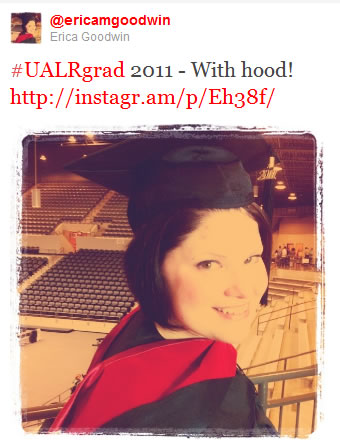

 Photo submission: Aveen Rasol
Photo submission: Aveen Rasol

